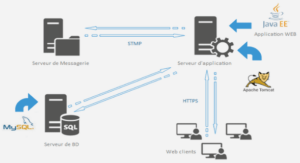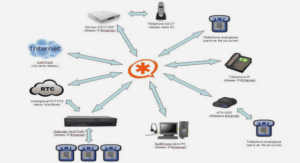Smart Grid Communications
For a reliable smart grid, monitoring of the power system parameters in the transmission and distribution segments as well as monitoring and control of substation devices from outside the station is crucial Fang et al. (2012); Farhangi (2010). In order to allow such advanced functionalities and avoid possible disruptions in electric systems due to unexpected failures, a highly reliable, scalable, secure, cost-effective, and robust communication network must be operational within the power grid Gungor et al. (2011); Yan et al. (2013). Basically, smart grid communication networks can be divided into three segments namely: home area networks (HANs), neighbor area networks (NANs), and wide area networks (WANs) .
– Home area network: HAN is applicable for home automation. It creates a communication path among smart meters, home appliances (e.g.: freezer, microwave oven, washing machine, dryer, water heater, TV), and plug-in electric vehicles. By doing this, utilities will be able to communicate with the consumers to monitor and inform their possible power consumption. In addition, consumers will be able to collect information about their consumption behaviors and the electricity usage costs from different utilities via in-home display panels.
– Neighbor area network: NANs establish a communication path between data collectors and smart meters in a neighborhood area such that the measured data from the smart meters can be transmitted to the data concentrators .
– Wide area network: WANs serve as the backbone for communication between the service provider’s data center and data concentrators. For that, it covers long distance data transmissions for smart grid monitoring and control applications.
Many researchers and international organizations are working for the development of versatile communication technologies and standards for smart grid automation. The common communication technologies include power line communication, optical fiber communication, satellite communication, wireless communication, and so forth. Each communication technology has its own advantages and disadvantages according to the location and requirement of the application Gungor, V. C. & Lambert, F. C. (2006). In the following, we briefly discuss these communication technologies along with their advantages and disadvantages.
Power Line Communication
The power line communication (PLC) is one of the earliest initiatives for the automation of the electrical grid. It involves the transmission of data and electricity simultaneously over existing power lines without necessitating dedicated communication infrastructure for the twoway data communication. On the basis of the frequency bandwidth, PLC can be divided into two categories: broadband PLC and narrowband PLC. Narrowband PLC is well suited for low data rate applications such as advanced metering infrastructure (AMI) in urban areas, data communication between the smart meters and the data concentrators, and for HAN purposes Gungor & Lambert (2006). Advantages of PLC include Gungor & Lambert (2006); Gungor et al. (2011): low installation cost given the existing infrastructure and extensive coverage since the power lines are already installed everywhere. The disadvantages of PLC are the following Gungor & Lambert (2006); Gungor et al. (2011): the power lines have several noise sources such as power supplies, electric motors, and radio interference which cause high BER during data transmission and hence degrade the performance of PLC. Also, PLC is characterized by a highly time varying nature and it is hard to model the characteristics of the channel.
Satellite Communication
Satellite communication can be an excellent alternative communication infrastructure for remote control and monitoring of substations in scenarios where other communication infrastructures such as telephone or cellular networks might not exist Gungor & Lambert (2006); Khan, F., ur Rehman, A., Arif, M., Aftab, M. & Jadoon, B. K. (2016). In addition, it can be used as a backup for the existing substations automation communication network. Specially, in case of equipment disaster, terrestrial link failure, network or link congestion, critical data in smart grid systems can be routed through satellite systems Gungor & Lambert (2006). Furthermore, satellite global positioning system (GPS) can be used for time synchronization in smart grid communications with accuracy in the microsecond range. Due to these reasons, the application of satellite communication for remote substation monitoring has already been considered Tisot, A. (2004). The benefits of satellite communication include wide geographical coverage and rapid installation compared to wired networks. The disadvantages are that it requires longer round-trip delay, higher cost, short life-span, sensitive to weather conditions and the effect of fading, which may heavily degrade the performance.
Optical Fiber Communication
Optical fiber communications system can be one of the technically attractive communication infrastructures for high voltage substation environments, providing extremely high data rate, with an immunity to electromagnetic interference (EMI) and radio frequency interference (RFI) Gungor & Lambert (2006). Furthermore, the existing optical fiber communication might be useful for backbone communication due to its high bandwidth capacity.
Although optical fiber communication systems offer several advantages compared to other wired and wireless networks, the corresponding installation cost might be expensive for remote control and monitoring of substations. Also, the substation equipment are not usually equipped to access the fiber network. Hence, from an economic point of view, it would be too expensive to deploy optical networks only for smart grid applications.
Wireless Communications
There are different wireless communication technologies that can be used for smart grid communication Gungor & Lambert (2006); Gungor et al. (2011); Khan et al. (2016). Wireless communication technologies have significant advantages over wired communications, such as, rapid installation of the communication infrastructure and saving in cabling cost Gungor & Lambert (2006). On the other hand, the performance of wireless communications is limited by bandwidth efficiency, maximum distances among communication devices, EMI, and channel fading. Basically, smart grid communications can be supported either by an existing wireless communication infrastructure of a public network (e.g., public cellular network) or by installing a dedicated wireless network. In the following, we describe both of these wireless communication technologies.
Cellular Communications
The cellular network has the advantage of being the most deployed wireless communication technology and can be a good option for communication between smart meters and the utility. This avoids spending operational costs and time for building a dedicated communication infrastructure. Existing cellular communication technologies are 2G, 2.5G, 3G, WiMAX, and LTE. These technologies have found numerous applications in HAN for home monitoring and load control. For example, in such applications, subscriber identity module (SIM) card can be embedded in the smart meters and the recorded data is relayed to the control panel of the smart grid via the cellular network. By this way, the domestic users are always in touch with their home appliances via their mobile phone. Nowadays, utility companies from different countries all over the world are using these cellular communication technologies for smart grid applications (e.g., T-mobiles GSM network is chosen for the deployment of Echelon’s Networked Energy Services (NES) system; Telenor, Telecom Italia, China Mobile, Vodaphone have also agreed to put their GSM network for smart meter communications) Gungor et al. (2011). The feasibility of LTE is investigated in Cheng, P., Wang, L., Zhen, B. & Wang, S. (2011) to support smart metering and remote control communications in smart grid environments. On the other hand, WiMAX is the most interesting cellular technology for smart grid communications. It is more applicable as a backbone solution for smart grid applications. Also, WiMAX chip based smart meters are already deployed for smart grid environments Gungor et al. (2011). The potential benefits of using today’s WiMAX technology are high data rates (up to 75 Mbps), lower deployment and operating costs, large coverage area, proper security protocols, smooth communications, adequate bandwidth, scalability, etc.
INTRODUCTION |





